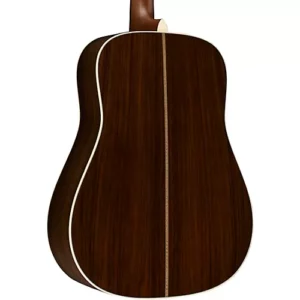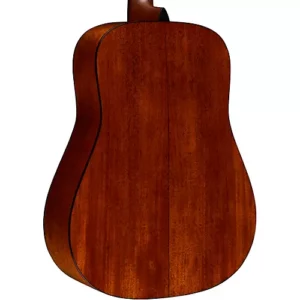The world of acoustic guitars offers various tonewoods with unique sound characteristics. Rosewood and Mahogany are two of the most popular choices for the back and sides of a guitar.
At first glance, you may only notice a difference in coloration between the two. But these two kinds of wood respond differently to your playing and impact your guitar tone.
Musicians need to consider their personal preferences and need when selecting between rosewood and mahogany guitars. While both tonewoods offer unique advantages, the ideal choice ultimately boils down to the individual player’s tonal and aesthetic preferences and needs.
This article will pair the two back and sides tonewood giants against each other so you can be confident in your selection as you shop for your next guitar.
Overview of Tonewoods
Rosewood Guitars

Rosewood, known for its rich, complex, and bell-like tonal qualities, is commonly used for the back and sides of acoustic guitars and the guitar’s fretboard.
Rosewood absorbs sound well, which reduces reflections. This creates melodic overtones and the thick tonal characteristics many acoustic guitarists seek.
An acoustic guitar with Rosewood back and sides aren’t the most balanced-sounding instrument regarding frequency response. There will be a strong bass response with a dip in the midrange. However, this natural mid-dip creates an excellent sonic opening for a vocalist, making this a fantastic option for singer/songwriters.
Rosewood also “chews” on the sound more and builds upon itself. There is better sustain and less immediacy in a rosewood back and sides guitar, which makes for an exciting playing experience.
Mahogany Guitars

Mahogany provides a warmer, snappier, and more organic sound. It is characterized by a pronounced midrange, less bass response, and is a touch brighter than Rosewood. This makes it ideal for players seeking clarity and a more focused tone, suitable for fingerpicking, single-note playing, and recording.
Also, because Mahogany is a dryer wood, it reflects sound more immediately. This can make Mahogany more transparent in its coloration and allow the topwood to be the primary sound in the acoustic guitar’s tone.
Mahogany acoustic guitars have an open sound quality that has less sustain. Mahogany can also be used for acoustic guitar tops. You get a vintage and mellow-sounding guitar when paired with a Mahogany back and sides.
Pros and Cons
Rosewood Pros and Cons
Pros: Rosewood is highly regarded for being a dynamic tonewood. It’s also very dense, contributing to its sustain and projection. It is popular for acoustic guitar back and sides, especially for modern performance guitars.
Cons: Rosewood can be heavy, and some players may prefer Mahogany’s purity of notes, especially in the bass. It’s also more expensive due to the increased demand and limited supply.
Mahogany Pros and Cons
Pros: Mahogany is a lighter-weight tonewood emphasizing a clear, articulated treble and pronounced midrange. Mahogany is commonly used for acoustic guitar necks, backs, sides, and electric guitars due to its well-balanced, warm, and resonant tone.
Also, there are lots of affordable substitutions of Mahogany like Sapele. So you often have more options for getting the Mahogany sound in a wide range of more budget-friendly guitars.
Cons: One downside of Mahogany is that it may lack the sweet thickness and low-end depth in Rosewood. However, this can benefit players seeking a mellower sound with more controlled dynamics.
Tonal Characteristics Comparison
Rosewood is known for its elegant appearance and offers strong highs and lows, creating an overtone-rich, almost saturated guitar tone.
On the other hand, Mahogany has a lighter weight, less stiffness, and a unique dampening factor, leading to a warmer sound with less sustain and more emphasis on the mid-range.
As stated throughout this article, mahogany guitars have a dryness and clarity that help separate notes and make the sounds balanced and compressed. This sound characteristic of mahogany guitars is what makes them fantastic for recording.
Rosewood has a sweeter sound that unifies notes in chords and has a more resonant sound. Rosewood is often paired with a spruce top, and this combination has a wide dynamic range. The more you push into it, the more it gives you.
However, this dynamic range can sometimes be challenging for fingerstyle players because you need better control over your playing dynamics to keep the sound even. It also reduces the clarity of individual notes, especially in faster arpeggiated picking patterns.
It is important to note that each guitar may vary slightly in tonal characteristics due to the specific piece of wood used in its construction (1). Remember, you’re dealing with a real piece of wood, so you must try out acoustic guitars before you buy or purchase from a reputable online dealer like Sweetwater to ensure that the guitar you purchase is resonant and not dead sounding.
Genre and Playing Style Preferences
Mahogany tonewood is known for its warm sound, balanced bass, and good midrange, making it well-suited for genres like blues, folk, and jazz. Its mellow tones work particularly well for strumming, lead lines, and often is found on some of the best fingerstyle acoustic guitars. Also, suppose you pair Mahogany with a Mahogany-topped acoustic guitar. In that case, you get a more vintage vibe to the sound of your guitar.
Rosewood, on the other hand, produces a richer sound with pronounced lows and complex overtones. This makes it well-adapted for a wider dynamic range and is ideal for genres where overtones and a deep bass sound are desirable, such as rhythm performances and for singer/songwriters.
However, the choice between these two tonewoods will ultimately depend on the player’s preferences and the desired sound for their specific genre and playing style. Remember, it’s the player and not the tool.
Durability
Rosewood’s a dense wood can make it more challenging to work with during the guitar construction process. But this also makes it incredibly durable and less prone to cracks if taken care of.
However, it’s worth noting that Rosewood has many variants, and depending on the variant will affect the wood’s durability. Some players have experienced Brazilian Rosewood to be more “fragile” than an East Indian Rosewood guitar.
Being lighter, Mahogany is easier to shape and manipulate for the guitar builder. It’s also considered a dense wood and is often used for a guitar’s back, sides, and neck due to its durability.
Both tonewoods are relatively resistant to humidity and climate changes. However, with any guitar, you should properly store it and use a guitar humidifier to prevent any weather damage.
You should also consider the overall construction quality and the guitar’s craftsmanship. A well-made mahogany guitar may outperform a poorly constructed rosewood guitar and vice versa. Remember that the choice of tonewood is just a single aspect of a guitar’s overall build.
Cost Considerations
The cost differences in the Mahogany vs. rosewood debate can influence your decision.
Rosewood tends to be more expensive due to its increasing scarcity and subsequent conservation efforts, with many species on the CITES list (click here for reference on CITES). It is also often considered a more complicated wood to work with due to its density and hardness.
On the other hand, Mahogany is relatively easy to work with and has more affordable variants while still offering excellent tonal characteristics. Certain Mahogany breeds are also on the CITES list, so prices for these guitars are increasing as supply decreases.
It’s also critical to note that not all guitars labeled with a “Rosewood” or “Mahogany” back and sides are genuine solid wood. They will use laminated back and sides for a more affordable acoustic instrument. This could either be layers of wood bonded together or a synthetic material made to look like wood. If the spec sheet doesn’t say “Solid (insert wood),” it’s most likely a laminate.
The brand of guitar you are buying will also affect the cost.
Sustainability
As mentioned before, both Rosewood and Mahogany are on the CITES list. This means that both kinds of wood have been overharvested, and now guitar manufacturers are looking for alternatives with both types of wood for building guitars.
Taylor Guitars has been one of the leading brands experimenting with alternative and sustainable woods (check Taylor’s sustainability efforts here).
Other guitar brands leading the charge are:
- Martin Guitars
- Breedlove
So while Rosewood and Mahogany are the “household” name in the guitar world, don’t be shy to explore the alternatives to ensure we support the environment and businesses that practice sustainable practices.
And The Winner Is?
It depends. I know this isn’t the answer you were hoping for when you wanted a definitive answer to make your choice easier; my apologies 🙂
Both tonewoods offer unique qualities and characteristics that can enhance your playing experience. Ultimately, the decision comes down to personal preference and the sound you want to achieve. Whether you prefer the midrange depth and articulation of Mahogany or the overtones and dynamics of Rosewood, both tonewoods can produce beautiful, rich tones that will make your guitar sing.
So, choose the tonewood that speaks to you and start creating music that will resonate with you and your audience for years to come.

